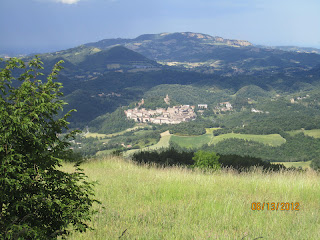I've always wanted to go some place no one has discovered yet and I finally got my wish. As it turns out, the undiscovered places are wonderful but there are downsides as you'll see later.
The Great Ring of the Sibillini (sounds like a Tolkien book, no?) is in the Appenine Range of Italy (the spine that goes straight up the center of the country) on the border between Umbria and Marche (pronounced Mar'kay) northeast of Rome. The Sibillini National Park was created quite recently (1993) and the Grande Anello (which goes by its Italian acronym, GAS) was developed to circumnavigate the park and give the hiker a taste of all its glories. As part of developing the GAS, Park officials made sure that there were "rifugios" or hostels available at daylong hiking intervals. We generally prefer to have our own bathroom so we stayed in B&B's and hotels. The official GAS is 120 km long, with several options for alternate routes and side trips. Arthur and I walked it at a leisurely pace in a week starting on June 10. Although there were still snow patches on the highest reaches of the mountains, the weather was hot and dry. I'd guess the temperature was in the 80s during the day. We started with a stay in Norcia (pronounced Norcha) which is a lovely medieval walled town and the birthplace of St. Benedict and his twin sister Scholastica. Norcia also appears to be the capital of the foodie universe, home to prime black truffle and wild boar hunting grounds and such a haven for prosciutto and salami making that many stores elsewhere are given the genus Norceria, connoting they specialize in those two products. Norcia is a short (10 km) taxi ride from Campi Vecchio where we started our hike. In many ways we chose the ideal time for our hike because the wildflowers were at peak bloom and the heat was tolerable. Yet the trail was deserted. It looked like there were a lot of people climbing Monte Vettore (the highest peak in the park) but we didn't ourselves climb it. We saw very few other hikers at all (except in the Piano Grande where people flock during wildflower season to take photos (but they mostly arrive by car))and many of the hostels, B&Bs, and restaurants were closed. As a result of the trail's being "undiscovered", the treadway wasn't beaten down in many places and we had a hard time finding places to stay and eat. In addition, often people didn't speak English (or Spanish or French) so communications required a bit of effort. These "hardships", however, gave way to a number of serendipitous occasions. The hosts at one B&B had offered to take us to town to eat at a restaurant but when we learned they were both closed they made dinner for us from their own home-canned tomatoes, wine, olive oil, and artichoke hearts. Because no taxis or buses were available when we finished, a kind man who I approached for help calling a taxi offered us a ride back to Norcia and wouldn't take any payment.
I was sorry that we hadn't allowed more time for side trips because I could easily have spent much more time enjoying the riches of the park. I used as a guide the excellent book Italy's Sibillini National Park. Walking and Trekking Guide by Gillian Price (published by the wonderful Cicerone Press in 2009) and I bought in Norcia the Parco Nazionale di Monti Sibillini carta dei sentieri (hiking map) which was far more useful than the more widely available Kompass map #666 (Monti Sibillini bike and hike map). The website for the Monti Sibillini National Park is excellent and many portions are translated into English: http://www.parks.it/parco.nazionale.monti.sibillini/Eindex.php.
Here is a selection of the photos from the trip. We took the Castellucchio variant, which eliminated the section from Forca di Presta until the junction just before Forca de Giuda. but which added the Piano Grande (great plain) and the enchanting town of Castellucchio which occupies a hill above the Piano.



























No comments:
Post a Comment